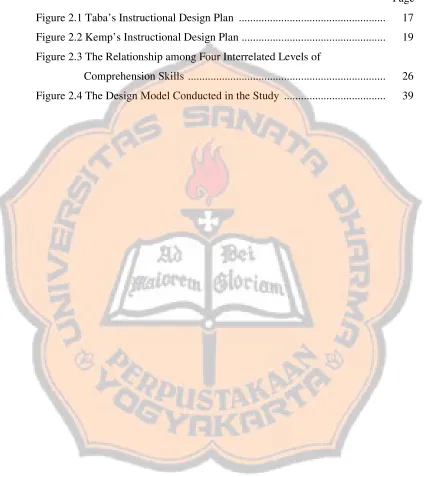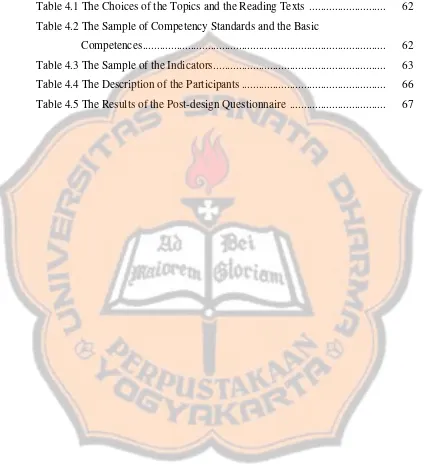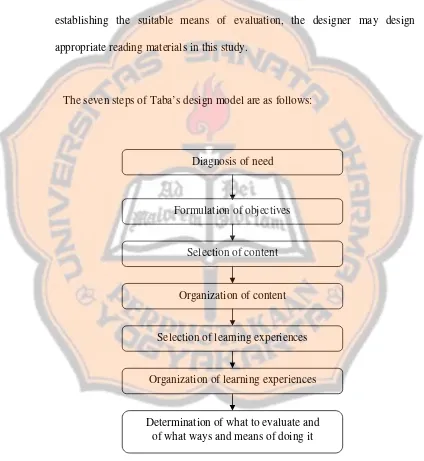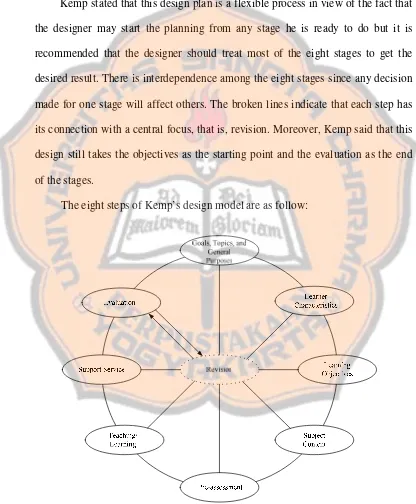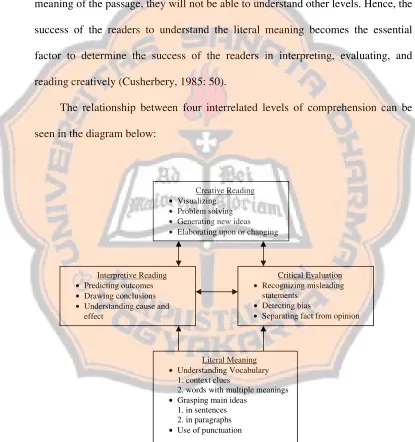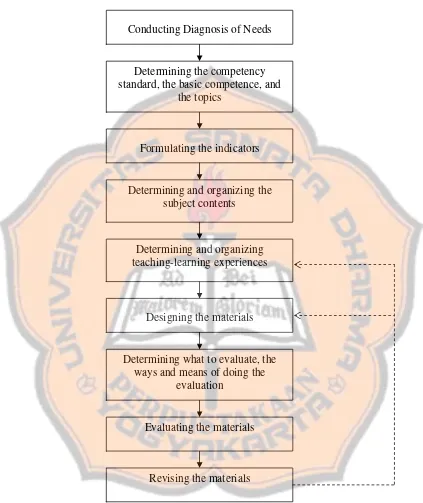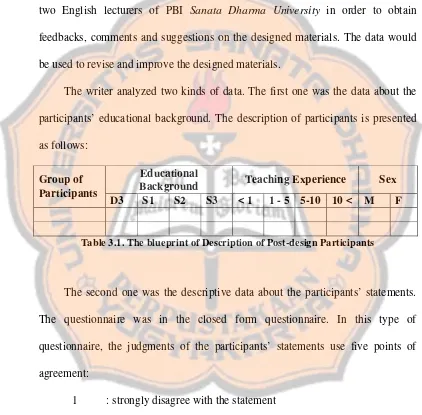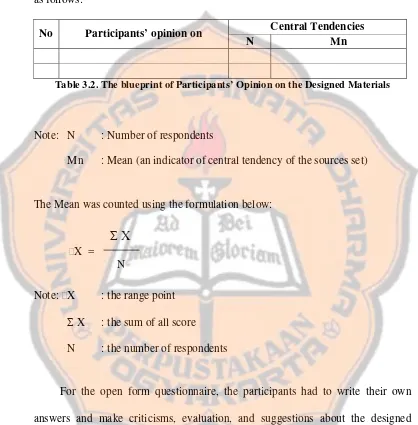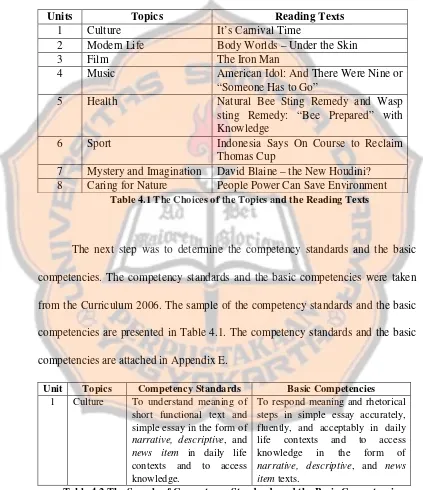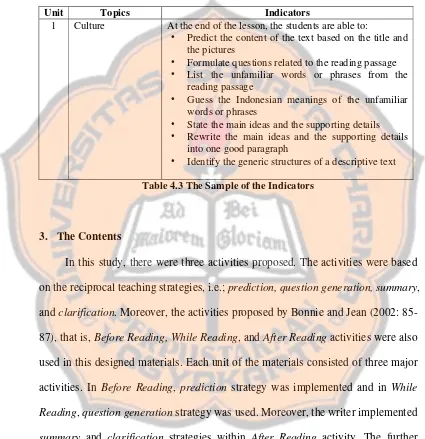xv ABSTRACT
Astuti, Reni Yuliana Kusuma. 2008. English Reading Instructional Materials Based on Reciprocal Teaching Strategy for the Tenth Grade Students of SMA STELLA DUCE 1 Yogyakarta. Yogyakarta: English Language Education Study Program, Sanata Dharma University.
The success of reading determines the success of learning (Nunan, 2003: 72). Therefore, the ability of the students to gain the meaning of what is being read becomes the significant factor to determine their learning achievement. On the other hand, reciprocal teaching provides the students four skills which support their reading comprehension mastery. They are predicting, questioning, summarizing, and clarifying. Based on the research conducted by Brown and Palinscar (1984), the application of four skills of reciprocal teaching in reading class showed the improvement of comprehension mastery of the middle school students. Thus, the introduction of reciprocal teaching in our local content area needs to conduct in order to increase the students reading comprehension.
This study was conducted to design English reading instructional materials based on reciprocal teaching strategy for the tenth grade students of SMA STELLA DUCE 1 Yogyakarta. This study had two research questions: 1) How are English reading instructional materials based on reciprocal teaching strategy for the tenth grade students of SMA STELLA DUCE 1 Yogyakarta designed? and 2) What do English reading instructional materials based on reciprocal teaching strategy for the tenth grade students of SMA STELLA DUCE 1 Yogyakarta look like? To answer two questions above, the writer employed five steps of R & D cycle. The steps were: (1) Research and Information Collecting, (2) Planning, (3) Development of Preliminary Form of Product, (4) Preliminary Field Testing, and (5) Main Product Revision.
In order to answer the first question, the writer adapted Taba’s and Kemp’s instructional design models. The writer employed nine steps. The steps were: (1) Conducting diagnosis of needs; (2) Determining the competency standards, the basic competences, and the topics; (3) Formulating the indicators; (4) Determining and organizing the subject contents; (5) Determining and organizing the teaching-learning experiences; (6) Designing the materials; (7) Determining what to evaluate, the ways and the means of doing the evaluation; (8) Evaluating the materials; and (9) Revising the materials. Based on the result of the evaluation analysis, it was signified that the mean was 4.04 on a scale of 1-5. It is concluded that the designed materials are good and acceptable. In order to answer the second question, the writer presented the final version of the designed materials after conducting some revisions based on the feedbacks, comments, and suggestions from the post-design participants. The final version of the designed materials consists of eight units and each unit consists of three sections, that is, Before Reading, While Reading, and After Reading.
xvi ABSTRAK
Astuti, Reni Yuliana Kusuma. 2008. English Reading Instructional Materials Based On Reciprocal Teaching Strategy for the Tenth Grade Students of SMA STELLA DUCE 1 Yogyakarta. Yogyakarta: Pendidikan Bahasa Inggris, Universitas Sanata Dharma.
Keberhasilan membaca menentukan keberhasilan pembelajaran (Nunan, 2003: 72). Oleh karena itu, kemampuan siswa dalam memperoleh makna bacaan menjadi faktor penting yang menentukan keberhasilan mereka dalam belajar. Di satu sisi, reciprocal teaching menyediakan empat strategi yang mendukung penguasaan pemahaman menbaca bagi siswa. Keempat strategi tersebut adalah predicting, questioning, summarizing, dan clarifying. Berdasarkan studi yang dilaksanakan oleh Brown dan Palinscar (1984), penerapan empat strategi dalam reciprocal teaching di kelas membaca menunjukkan adanya peningkatan penguasaan pemahaman bacaan pada siswa sekolah menengah. Pengenalan reciprocal teaching pada siswa di Indonesia perlu dilakukan demi meningkatkan pemahaman membaca mereka.
Studi ini dilaksanakan untuk merancang materi pembelajaran reading berdasarkan strategi reciprocal teaching bagi siswa kelas sepuluh SMA STELLA DUCE 1 Yogyakarta. Studi ini mengemukakan dua pertanyaan: 1) Bagaimana materi pembelajaran reading berdasarkan strategi reciprocal teaching bagi siswa kelas sepuluh SMA STELLA DUCE 1 Yogyakarta didesain? dan 2) Bagaimanakan bentuk materi pembelajaran reading berdasarkan strategi reciprocal teaching bagi siswa kelas sepuluh SMA STELLA DUCE 1 Yogyakarta? Untuk menjawab dua pertanyaan tersebut, penulis menggunakan lima langkah dari metode siklus R & D (Research and Development). Lima langkah tersebut adalah: (1) Mengumpulkan informasi, (2) Perencanaan, (3) Pengembangan bentuk awal dari produk, (4) Pengujian awal di lapangan, dan (5) Perbaikan produk utama.
Untuk menjawab pertanyaan pertama, penulis mengadaptasi model pembelajaran dari Taba dan Kemp. Penulis menerapkan sembilan langkah: (1) Mengadakan diagnosis kebutuhan; (2) Menentukan standard kompetensi, kompetensi dasar, dan topik; (3) Merumuskan indicator; (4) Menentukan dan mengatur kegiatan pembelajaran; (5) Menentukan dan mengatur kegiatan belajar mengajar; (6) Merancang materi; (7) Menentukan apa yang dievaluasi, cara dan alat untuk mengevaluasi, (8) Mengevaluasi materi; dan (9) memperbaiki materi. Berdasarkan hasil dari analisa data evaluasi, diperoleh nilai rata-rata 4.04 dari skala 1-5. dari hasil tersebut, dapat disimpulkan bahwa materi yang dirancang ini sudah baik dan dapat diterima. Untuk menjawab pertanyaan kedua, penulis menyajikan versi akhir dari materi yang dirancang berdasarkan revisi dari masukan, komentar, dan saran dari responden. Versi akhir dari materi yang dirancang terdiri dari delapan unit dan masing-masing unit terdiri dari tiga bagian, yaitu, Before Reading, While Reading, dan After Reading.
i
ENGLISH READING INSTRUCTIONAL MATERIALS
BASED ON RECIPROCAL TEACHING STRATEGY FOR THE TENTH
GRADE STUDENTS OF SMA STELLA DUCE 1 YOGYAKARTA
A Thesis
Presented as Partial Fulfillment of the Requirements to Obtain the Sarjana Pendidikan Degree
in English Language Education
By
Reni Yuliana Kusuma Astuti Student number: 021214118
ENGLISH LANGUAGE EDUCATION STUDY PROGRAM DEPARTMENT OF LANGUAGE AND ARTS EDUCATION
FACULTY OF TEACHERS TRAINING AND EDUCATION SANATA DHARMA UNIVERSITY
vi
!
" #
$
"
!
%
!
%
!
!
!
&
!
!
vii
ACKNOWLEDGEMENTS
First of all, I would like to dedicate my gratitude to God, Allah SWT, for the blessing, love, and the kindness in my life so that I finally finished my thesis. I realize that all of these happened because of His grace.
I would like to show my great thanks to my major sponsor, Gregorius Punto Aji, S.Pd., M.Hum. and my co-sponsor, C. Tutyandari, S.Pd., M.Pd., for always giving me a lot of advice and attention in the process of finishing my thesis as well as giving detailed corrections to improve my thesis.
Next, I would like to address my gratitude to the English teachers in SMA Stella Duce 1 Yogyakarta, Fransisca Awan Tyaswati, S.Pd. and Sweet Suzi Maria, S.Pd., for their willingness to give valuable suggestions for my designed materials. I also address my thanks to the tenth grade students for their help in filling in the questionnaires.
Special appreciation also goes to all lecturers of the English Language Education Study Program for their kindness and patience. They have given me a lot of enjoyable experiences during my study in this university. I would also like to say thanks to PBI staffs, mbak Tari and mbak Danik, for giving me nice services.
My deeply gratitude goes to my beloved parents, Bapak Joko Riyanto, S.Pd. and Ibu Suharsi, for their love, care, understanding, patience, and prayers. The same gratitude also addresses to my lovely sisters and brother, dik Rina, dik
Ria, and dik Yoga, for all fascinating experiences in my life.
viii
wonderful friendship. I thank them for their support, help, care, and laugh during our golden era moments.
With all my love, I give my thanks to Taufik Kumara for his love and for being my everything. He will always be my shoulder to cry on and I am thankful to him for always being here whenever I need help. I also thank him for his care, patience, support, and laugh during all this time. The same appreciation also goes to Bapak, Ibu, and Citra for their love and warmth.
I never forget my magnificent friends in PBI 2002: mbakyu Ikas, Regina, Nce’, Aray, Sisil, Ayu, Agus “Genjik”, Dani, Galih, Ila, Niken, Dedy, and Gabo. These people always supported and encouraged me to accomplish my thesis. They gave me valuable inputs to make my thesis better. I also thanked them for all happy and sad moments that we shared during our study in English Language Education Study Program. I will never forget our lovely time together.
Last but not least, I would also express my appreciation to those who have given me a hand, whom I have not mentioned.
ix
TABLE OF CONTENTS
Page
TITLE PAGE ... i
APPROVAL PAGES ... ii
STATEMENT OF WORK’S ORIGINALITY ... iv
DEDICATION PAGE ... vi
ACKNOWLEDGEMENTS ... vii
TABLE OF CONTENTS ... ix
LIST OF FIGURES ... xiii
LIST OF TABLES ... xiv
ABSTRACK ... xv
ABSTRAK ... xvi
CHAPTER I: INTRODUCTION ... 1
A. Research Background ... 1
B. Problem Formulation ... 4
C. Problem Limitation ... 4
D. Research Objectives ... 5
E. Research Benefits ... 5
F. Definition of Terms ... 6
CHAPTER II: REVIEW OF RELATED LITERATURE ... 9
A. Theoretical Description ... 9
1. Curriculum Based Materials Development ... 9
a. Curriculum ... 9
1) Curriculum as content ... 10
2) Curriculum as product ... 10
3) Curriculum as process ... 11
4) Curriculum as praxis ... 12
b. School Based Curriculum ... 13
x
a. The Nature of Taba’s model ... 15
b. The Nature of Kemp’s model ... 18
3. Theory of Reading ... 20
a. The Nature of Reading ... 20
b. The Models of Reading Processes ... 21
1) Bottom-up model ... 22
2) Top-down model ... 22
3) Interactive model ... 23
4) Interactive-compensatory model ... 24
c. The Levels of Comprehension ... 24
1) Literal meaning ... 24
2) Interpretive reading ... 24
3) Critical evaluation ... 25
4) Creative reading ... 25
d. The Teaching Reading Skills ... 27
1) Pre-reading activity ... 27
2) While-reading activity ... 28
3) Post-reading activity ... 29
4. Cognitive Strategy Instruction ... 30
5. Reciprocal Teaching ... 31
B. Theoretical Framework ... 34
CHAPTER III: METHODOLOGY ... 40
A. Research Method ... 40
1. Pre-design Study ... 41
2. Material Development ... 42
3. Post-design Study ... 43
B. Research Participants ... 43
1. Participants of Pre-design Study ... 44
2. Participants of Post-design Study ... 44
C. Research Instruments ... 45
xi
2. Post-design Study ... 47
D. Data Gathering Technique ... 48
1. Pre-design Study ... 48
2. Post-design Study ... 48
E. Data Analysis Technique ... 49
1. Pre-design Study ... 49
2. Post-design Study ... 50
F. Research Procedure ... 52
CHAPTER IV: RESEARCH FINDINGS AND DISCUSSIONS ... 54
A. The Material Development ... 54
1. Conducting Diagnosis of Needs ... 54
a. The Results of the Interview with the English Teacher ... 55
b. The Results of the Questionnaire Distributed to the Tenth Grade Students ... 56
2. Determining the Competency Standards, the Basic Competencies, and the Topics ... 58
3. Formulating the Indicators ... 59
4. Determining and Organizing Contents ... 59
5. Determining and Organizing Teaching Learning Experiences ... 59
6. Designing the Materials ... 60
7. Determining What to Evaluate, the Ways and Means of Doing It ... 60
8. Evaluating the Designed Materials ... 61
9. Revising the Designed Materials ... 61
B. The Designed Materials ... 61
1. The Competency Standards, the Basic Competencies, and the Topics ... 61
2. The Indicators ... 63
3. The Contents ... 63
a. Before Reading ... 63
b. While Reading ... 64
xii
4. The Teaching Learning Experiences ... 65
5. What to Evaluate, the Ways and Means of Doing It ... 65
6. The Evaluation of the Designed Materials ... 66
a. The Results of the Post-design Questionnaire ... 66
b. Participants’ Comments and Suggestions on the Designed Materials ... 68
7. The Revision of the Designed Materials ... 69
a. Responses to the Participants’ Evaluation ... 69
b. The Presentation of the Designed Materials ... 70
CHAPTER V: CONCLUSIONS AND SUGGESTIONS ... 71
A. Conclusions ... 71
B. Suggestions ... 73
REFERENCES ... 74
APPENDICES ... 76
Appendix A : Letters of Permission ... 77
Appendix B : Interview Guideline, Pre-design and Post-design Questionnaires ... 79
Appendix C : The Results of the Interview ... 87
Appendix D : The Results of the Pre-design Questionnaire ... 91
Appendix E : The Competency Standards and the Basic Competencies ... 95
Appendix F : The Indicators ... 98
Appendix G : The Topics, the Reading Texts, the Sections and the Sub-sections of the Designed Materials ... 102
Appendix H : The Time Distribution of the Designed Materials ... 109
Appendix I : The Syllabus ... 112
xiii
LIST OF FIGURES
Page Figure 2.1 Taba’s Instructional Design Plan ... 17 Figure 2.2 Kemp’s Instructional Design Plan ... 19 Figure 2.3 The Relationship among Four Interrelated Levels of
xiv
LIST OF TABLES
Page
Table 4.1 The Choices of the Topics and the Reading Texts ... 62
Table 4.2 The Sample of Competency Standards and the Basic Competences... 62
Table 4.3 The Sample of the Indicators... 63
Table 4.4 The Description of the Participants ... 66
xv ABSTRACT
Astuti, Reni Yuliana Kusuma. 2008. English Reading Instructional Materials Based on Reciprocal Teaching Strategy for the Tenth Grade Students of SMA STELLA DUCE 1 Yogyakarta. Yogyakarta: English Language Education Study Program, Sanata Dharma University.
The success of reading determines the success of learning (Nunan, 2003: 72). Therefore, the ability of the students to gain the meaning of what is being read becomes the significant factor to determine their learning achievement. On the other hand, reciprocal teaching provides the students four skills which support their reading comprehension mastery. They are predicting, questioning, summarizing, and clarifying. Based on the research conducted by Brown and Palinscar (1984), the application of four skills of reciprocal teaching in reading class showed the improvement of comprehension mastery of the middle school students. Thus, the introduction of reciprocal teaching in our local content area needs to conduct in order to increase the students reading comprehension.
This study was conducted to design English reading instructional materials based on reciprocal teaching strategy for the tenth grade students of SMA STELLA DUCE 1 Yogyakarta. This study had two research questions: 1) How are English reading instructional materials based on reciprocal teaching strategy for the tenth grade students of SMA STELLA DUCE 1 Yogyakarta designed? and 2) What do English reading instructional materials based on reciprocal teaching strategy for the tenth grade students of SMA STELLA DUCE 1 Yogyakarta look like? To answer two questions above, the writer employed five steps of R & D cycle. The steps were: (1) Research and Information Collecting, (2) Planning, (3) Development of Preliminary Form of Product, (4) Preliminary Field Testing, and (5) Main Product Revision.
In order to answer the first question, the writer adapted Taba’s and Kemp’s instructional design models. The writer employed nine steps. The steps were: (1) Conducting diagnosis of needs; (2) Determining the competency standards, the basic competences, and the topics; (3) Formulating the indicators; (4) Determining and organizing the subject contents; (5) Determining and organizing the teaching-learning experiences; (6) Designing the materials; (7) Determining what to evaluate, the ways and the means of doing the evaluation; (8) Evaluating the materials; and (9) Revising the materials. Based on the result of the evaluation analysis, it was signified that the mean was 4.04 on a scale of 1-5. It is concluded that the designed materials are good and acceptable. In order to answer the second question, the writer presented the final version of the designed materials after conducting some revisions based on the feedbacks, comments, and suggestions from the post-design participants. The final version of the designed materials consists of eight units and each unit consists of three sections, that is, Before Reading, While Reading, and After Reading.
xvi ABSTRAK
Astuti, Reni Yuliana Kusuma. 2008. English Reading Instructional Materials Based On Reciprocal Teaching Strategy for the Tenth Grade Students of SMA STELLA DUCE 1 Yogyakarta. Yogyakarta: Pendidikan Bahasa Inggris, Universitas Sanata Dharma.
Keberhasilan membaca menentukan keberhasilan pembelajaran (Nunan, 2003: 72). Oleh karena itu, kemampuan siswa dalam memperoleh makna bacaan menjadi faktor penting yang menentukan keberhasilan mereka dalam belajar. Di satu sisi, reciprocal teaching menyediakan empat strategi yang mendukung penguasaan pemahaman menbaca bagi siswa. Keempat strategi tersebut adalah predicting, questioning, summarizing, dan clarifying. Berdasarkan studi yang dilaksanakan oleh Brown dan Palinscar (1984), penerapan empat strategi dalam reciprocal teaching di kelas membaca menunjukkan adanya peningkatan penguasaan pemahaman bacaan pada siswa sekolah menengah. Pengenalan reciprocal teaching pada siswa di Indonesia perlu dilakukan demi meningkatkan pemahaman membaca mereka.
Studi ini dilaksanakan untuk merancang materi pembelajaran reading berdasarkan strategi reciprocal teaching bagi siswa kelas sepuluh SMA STELLA DUCE 1 Yogyakarta. Studi ini mengemukakan dua pertanyaan: 1) Bagaimana materi pembelajaran reading berdasarkan strategi reciprocal teaching bagi siswa kelas sepuluh SMA STELLA DUCE 1 Yogyakarta didesain? dan 2) Bagaimanakan bentuk materi pembelajaran reading berdasarkan strategi reciprocal teaching bagi siswa kelas sepuluh SMA STELLA DUCE 1 Yogyakarta? Untuk menjawab dua pertanyaan tersebut, penulis menggunakan lima langkah dari metode siklus R & D (Research and Development). Lima langkah tersebut adalah: (1) Mengumpulkan informasi, (2) Perencanaan, (3) Pengembangan bentuk awal dari produk, (4) Pengujian awal di lapangan, dan (5) Perbaikan produk utama.
Untuk menjawab pertanyaan pertama, penulis mengadaptasi model pembelajaran dari Taba dan Kemp. Penulis menerapkan sembilan langkah: (1) Mengadakan diagnosis kebutuhan; (2) Menentukan standard kompetensi, kompetensi dasar, dan topik; (3) Merumuskan indicator; (4) Menentukan dan mengatur kegiatan pembelajaran; (5) Menentukan dan mengatur kegiatan belajar mengajar; (6) Merancang materi; (7) Menentukan apa yang dievaluasi, cara dan alat untuk mengevaluasi, (8) Mengevaluasi materi; dan (9) memperbaiki materi. Berdasarkan hasil dari analisa data evaluasi, diperoleh nilai rata-rata 4.04 dari skala 1-5. dari hasil tersebut, dapat disimpulkan bahwa materi yang dirancang ini sudah baik dan dapat diterima. Untuk menjawab pertanyaan kedua, penulis menyajikan versi akhir dari materi yang dirancang berdasarkan revisi dari masukan, komentar, dan saran dari responden. Versi akhir dari materi yang dirancang terdiri dari delapan unit dan masing-masing unit terdiri dari tiga bagian, yaitu, Before Reading, While Reading, dan After Reading.
1 CHAPTER I INTRODUCTION
In this chapter, the writer will discuss six major points. They are research background, problem formulation, problem limitation, research objectives, research benefits, and some definition of terms to help understanding this study.
A. Research Background
Reading is one of the important skills that the students master. The success of reading determines the success of learning (Nunan, 2003: 72). Reading is complex. It is far beyond saying out words or citing the information from the text. As it is stated by Osman (1986: 4), the essential purpose of reading instructions is to develop the students’ ability in comprehending what they read. The ability of the students in decoding the words in the text is not sufficient for them to acquire the meaning of what they read. They have to relate new information from texts with their prior knowledge in order to construct meanings.
already known to make inference. Rhetorical knowledge facilitates the readers to construct inference. Inference rule knowledge introduces the readers the knowledge on how to draw conclusion from what they read.
In 1980s, many educators were trying to find the appropriate strategies to develop the readers’ comprehension (Resnick, 1987). They focused their attention on cognitive strategies. Paris and Jacob (1984), cited by Resnick (1987: 24), conducted a research on the effect of using skimming, using context to guess the meaning, and note taking for the elementary students. The result showed that there were some students called skilled-readers who could increase their understanding, and some students called unskilled-readers who could not. Then, the concern moved to the way of improving the understanding of the unskilled readers. Some researchers suggested developing self-monitoring skills where the students could monitor their own comprehension achievement. Thus, Brown and Palincsar (1984) introduced a reading approach called reciprocal teaching that enables the students to develop their interpretations on the written texts. This approach establishes some strategies: predicting, questioning, clarifying, and summarizing. Based on the research conducted by Brown and Palincsar, the application of reciprocal teaching strategies for middle-school children showed the improvement of reading comprehension of the readers even the unskilled readers (Resnick, 1987: 12).
class were monotonous. The teacher asked the students to read the passage and answer the comprehension questions provided. Then, the teacher and students discussed the answers together. If the students could not find the appropriate answers for the comprehension questions provided, the teacher would supply the correct ones.
It is important to know that the reading skill mastery is essential for the senior high school students in view of the fact that there are many information sources written in English, such as journals, textbooks, magazines, and articles. Due to the implementation of the monotonous English reading activity, it appears that the teaching of comprehension ability in the tenth grade is not developed at the optimum rate. Thus, it is hard for the students to understand the English references. Moreover, the time to practice reading comprehension skill in the classroom is limited.
To sum up, there is an urgent need to conduct a study. It is important for the students of SMA STELLA DUCE 1 Yogyakarta to be introduced to a new approach since there are numerous handbooks written in English and the need of comprehension mastery is crucial to determine their success of learning. This study focuses on the reading area as previous researchers tried to develop.
chooses this approach as it is an effective means to equip the students with some basic strategies to comprehend the English written texts, namely: predicting, generating question, summarizing, and clarifying. Moreover, by applying four strategies of reciprocal teaching in the reading class, the students will learn to monitor and be responsible for their own learning. Therefore, this study mainly concerns with designing English reading instructional materials based on reciprocal teaching strategies to improve students’ reading comprehension.
The writer chooses the tenth grade of senior high school students since they need to build strong basics of English to undergo the next levels successfully. Moreover, they need to study English continuously in order to acquire English well.
B. Problem Formulation
According to the problems stated in the background of the study, the formulated questions are as follow:
1. How are English reading instructional materials based on reciprocal teaching strategy for the tenth grade students of SMA STELLA DUCE 1 Yogyakarta designed?
2. What do English reading instructional materials based on reciprocal teaching strategy for the tenth grade students of SMA STELLA DUCE 1 Yogyakarta look like?
C. Problem Limitation
STELLA DUCE 1 Yogyakarta improve their reading comprehension. This study is
limited to the development of the materials. Therefore, in order to achieve the objectives of the study, the writer introduces one reading approach that can lead the tenth grade students of SMA STELLA DUCE 1 Yogyakarta to better comprehension named reciprocal teaching.
In this study, the writer would present English reading instructional materials based on reciprocal teaching strategy to improve the comprehension of the tenth grade students of SMA STELLA DUCE 1 Yogyakarta.
D. Research Objectives
There are two main objectives proposed by this study:
1. To develop English reading instructional materials based on reciprocal teaching strategy for the tenth grade students of SMA STELLA DUCE 1 Yogyakarta. 2. To present English reading instructional materials based on reciprocal teaching
strategy for the tenth grade students of SMA STELLA DUCE 1 Yogyakarta.
E. Research Benefits
This conducted study hopefully brings benefits for:
1. The senior high school students of SMA STELLA DUCE 1 Yogyakarta
and to be responsible for their own learning achievement. The students may also develop their reading skill not only in English area but also in other subject areas. 2. English teachers of SMA STELLA DUCE 1 Yogyakarta
The designed materials hopefully help the teachers monitor and improve the English mastery of the students. This design may also be used as an input for the teachers to determine the appropriate strategies for the reading lesson. Moreover, this design can aid the students do the English reading test in the National Examination (UN) successfully. In addition, this design may help the teachers to be more creative in providing English reading materials for their students.
3. Other researchers
This study may motivate other researchers who would like to focus their study on the reading area. Moreover, the designed materials can be used as the guidance to design other reading materials for further educational level.
F. Definition of Terms
To avoid misunderstanding, below are some definitions of terms: 1. Design
2. Instructional Material
According to Dick and Reiser (1989:3), instructional material is a set of materials which is used to deliver instructions to the learners. In this study, instructional materials means a set of materials provided for the students where it enables the students to gain specific skills in comprehending the English reading texts.
3. Reading
Nunan (2003:68) stated reading is a fluent process of readers combining information from a text and their own background knowledge to build meaning. In other word, reading is an active process of gaining knowledge. The success of the students in reading is indicated when they have been able to gain the meaning of the reading text they face and they can get the information from it.
4. Cognitive strategy
Cognitive strategy deals with the interpretation of the written text where it is supported by the background information possessed by the readers and the way the information is organized within the text (Simanjuntak, 1998:6). In this study, cognitive strategy is a strategy which is used to assist the students to organize their thinking to search for meaning whenever they deal with any educational tasks.
5. Reciprocal teaching
read. These strategies focus on the development of the students’ self-monitoring toward their learning. Furthermore, these strategies help the students to be aware of their used strategies to comprehend the written texts.
6. The tenth grade of Senior High School Students
9 CHAPTER II
REVIEW OF RELATED LITERATURE
There are two major points that will be discussed in this chapter. The first is about the theoretical description of related theories to the study and the second point is on the theoretical framework where it will be used as the guideline in designing the materials.
A. Theoretical Description
In this section, there are five topics to discuss. They are Curriculum Based Material Development, Instructional Design Models, Theory of Reading, Cognitive Strategy Instruction, and Reciprocal Teaching.
1. Curriculum Based Material Development
Since this study is conducted in educational institution, the concern of this study is drawn into the curriculum. In this discussion, there are two points to consider. They are curriculum and school-based curriculum.
a. Curriculum
curriculum as an attempt to achieve certain ends in students – product, curriculum as process, and curriculum as praxis.
As it is explained previously, there are four ways of approaching curriculum theory and practice. The further explanation will be discussed as follows:
1) Curriculum as a body of knowledge to be transmitted – content
When viewing curriculum as a body of knowledge/ content to be transmitted, people still consider curriculum as a syllabus. Smith viewed a syllabus as a concise statement or table of the heads of a discourse, the contents of a treatise, the subjects of a series of lectures (2000: 2). Furthermore, people who tend to compile a syllabus follow the traditional approach of an order of contents. When they still equate curriculum with syllabus, they limit their planning only on the contents of knowledge that they intend to transmit.
Therefore, the main concern when approaching curriculum theory and practice on syllabus is on its contents. On the other hand, curriculum is a body of knowledge/ contents and these contents have to be transmitted to the students by the most effective way (Blenkin et al, 1992: 23).
According to Bobbitt (1918), education is one of the means in preparing life whereas the life itself consists of performance of specific activities. Hence, the role of curriculum is to state objectives that show abilities, attitudes, habits, appreciations and forms of knowledge that people need. This stating of objectives will be resulting in numerous, definite, and particularized objectives. (Smith, 2000: 3-4).
In viewing curriculum as a product, the emphasis is on the formulation of behavioral objectives. The concern of this approach is on the outcomes of the students in the form of desired performance. As it is stated by Tyler (1949: 44), the purpose of education is to bring changes in students’ behavior. Therefore, the statement of objectives of the school should be a statement of changes on the students’ performance (Smith, 2000: 5).
3) Curriculum as process
When viewing curriculum as process, the focus is on the interactions among teachers, students, and knowledge. As it is stated by Smith (2000: 7), curriculum is what actually happens in the number of elements in constant interaction. Stenhouse (1975: 142) said that curriculum is a particular form of specification about the practice of teaching. It is far beyond covering materials or syllabus. It is a way of translating any educational idea into a hypothesis testable in practice. Moreover, it invites critical testing rather than acceptance. Curriculum is a matter of possibility and then it moves to be a subject of experiment. On the other hand, curriculum as process is a matter of experimentation. (Smith, 2000: 11).
involves testing. The contents and means will develop as teachers and students work together and share their thinking and, then, bring it into action. The students become the subjects of the learning since they take part actively in every session. The process curriculum brings about interpretation and meaning making. The expected outcomes in this approach are thinking and action.
4) Curriculum as praxis
Smith (2000: 12) said that this approach is the development of the process curriculum. In this approach, the activity is situated upon the experience of both teacher and student where they share their ideas through dialogue and negotiation to solve occurred problems toward their existence and relationships. They also try to make an explicit commitment to human emancipation (Grundy, 1987: 105). The outcome of this approach is praxis: informed and committed action.
In addition, the development of this approach depends on the dynamic interaction between action and reflection in which a curriculum is seen as an active process and planning, acting, and evaluating are related and integrated in the process (Grundy, 1978: 115). When practicing this approach, the attention is on the collective understandings and practices and on the structural questions. We need also to look for certain values especially action which is emphasized on human emancipation. There is a practice in which people share ideas about what makes for good and also its related theories.
bring about certain changes toward the students performance. In this approach, curriculum is arranged to meet the desired objectives through series of experiences. The product approach focuses on its behavioural objectives in the planning and it becomes the foundation to determine the contents and the methods of the teaching learning processes. When determining the objectives, the planner has set series of competencies to be achieved as the results of the outcomes. As it is stated by Smith (1996: 2), competencies are series of discrete activities that the people possess the necessary skills, knowledge and understanding to engage in effectively. The competency is part of the planning and it turns into the foundation to determine the content and method. Furthermore, the competency is also used to determine the evaluation of the planning. Therefore, the product approach will be used as the guideline in designing the materials.
b. School Based Curriculum
The discussion of the curriculum 2006 is limited to the Senior High School area since this study is conducted in a private senior high school. The private school chosen to conduct the study is SMA STELLA DUCE 1 Yogyakarta for the reason that this school has applied the use of the Curriculum 2006 in its teaching learning processes. As mentioned in the curriculum 2006, the senior high school students need to undergo three educational levels in order to graduate where there are some requirements to fulfill. It is stated in the curriculum 2006, for each level, the students have to achieve some standards at the end of their study and these standards are called graduate competency standards which determine the success of the students to experience the next levels. Whereas, these graduate competency standards are supported by competency standards and basic competencies which are ruled on every subject learnt at school. In order to achieve the graduate competency standards, the students have to approach the competency standards and the basic competencies which are required for each subject. On the other hand, when the students have succeeded in achieving the competency standards and the basic competencies of each subject, they have succeeded in achieving the graduate competency standards.
2. Instructional Design Model
In this research, there are two instructional designs to discuss. The writer employs Taba’s and Kemp’s models in order to answer the questions presented in the previous chapter. The models of Taba’s and Kemp’s designs are explained as follows:
a. The Nature of Taba’s Model
Taba (1962: 12) offers planning in which it is suited to view curriculum as product. The main concern of this planning is on the students’ outcomes; therefore, the stating of objectives becomes the main focus of the planning. There are seven stages in this planning. The explanation is as follows:
1) Diagnosis of Needs
The function of diagnosis of needs is to analyze the problems, the conditions, and the difficulties of the students as they come from different background of knowledge. Furthermore, the diagnosis of needs is conducted by drawing together the existing knowledge with the new information to get the new improvement for the new approach. In this study, the data analysis results are used to design the suitable reading instructional materials for the tenth grade students of SMA STELLA DUCE 1 Yogyakarta.
2) Formulation of Objectives
The formulation of specific objectives is determined by the results of the needs analysis since it will give clear direction to which aspects to emphasize and from the general objectives of the school.
3) Selection of Content
determine which aspects to put emphasis on. This stage encompasses three steps. The first step is the selection of topics. The second step is the selection of basic ideas. The last step is the selection of specific content.
4) Organizing of Content
The aim of organizing the content is to arrange the content according to the feasible learning sequence. The topics, the basic ideas, and the specific contents should be arranged from the known to unknown, from the concrete to the abstract, or from the easy to the difficult.
5) Selection of Learning Experiences
The important rule in selecting the learning experiences is that each learning experience should provide some definite functions. Therefore, it is important to visualize what the students need to do or experience in order to achieve some behavioural competencies and what the order of these experiences should be. Furthermore, the success of the students achieving the objective depends on the learning experiences which are used in the study.
6) Organizing of Learning Experiences
The next stage to conduct is to organize the learning experiences. The most important point in organizing learning experiences is that it follows a sequence to create continuous and accumulative learning. This learning sequence should include the generalization and abstraction, the development of central ideas, and the appropriate steps to attain concepts and attitudes.
components is important to do in order to correct some errors which may occur. Furthermore, it can be used to re-examine the total plan to see that there are no serious inconsistencies among the components. The results of the evaluation can be used to revise and make improvement on the designed materials. By establishing the suitable means of evaluation, the designer may design appropriate reading materials in this study.
The seven steps of Taba’s design model are as follows:
Figure 2.1 Taba’s Instructional Design Plan (Taba, 1962: 12) Diagnosis of need
Formulation of objectives
Selection of learning experiences Organization of content
Determination of what to evaluate and of what ways and means of doing it Organization of learning experiences
The seven steps above derive from the way of approaching curriculum theory and practice. The choice of the sequences is organized and systematic where the focus of the instruction is on the formulation of the objectives. Furthermore, the determination of objectives may promote the outcomes of the students and support the formulation of the contents, the method of teaching, and the evaluation.
b. The Nature of Kemp’s Model
In the design presented by Kemp (1977: 8), there are three essential elements of the instructional technology. These elements are objectives (what must be learnt), method (what procedures and resources will work best to reach desired learning level), and evaluation (how we will know if the desired learning level happens). Furthermore, this design can be implemented at any educational level. It can be treated to single topics and then to units and then to the whole courses (Kemp, 1977: 8).
There are eight stages offered by Kemp in order to sustain the three essential elements. The eight stages are:
1) Consider goals, list topics, and state general purpose for each topic. 2) List the important characteristics of the learners.
3) Specify the learning objectives in terms of behavioral outcomes. 4) List the subject content that support each objective.
5) Develop pre-assessment to determine the students’ background knowledge. 6) Select teaching/ learning activities and resources.
8) Evaluate the students’ accomplishment to do revision and reevaluation of the design in order to make improvement.
Kemp stated that this design plan is a flexible process in view of the fact that the designer may start the planning from any stage he is ready to do but it is recommended that the designer should treat most of the eight stages to get the desired result. There is interdependence among the eight stages since any decision made for one stage will affect others. The broken lines indicate that each step has its connection with a central focus, that is, revision. Moreover, Kemp said that this design still takes the objectives as the starting point and the evaluation as the end of the stages.
The eight steps of Kemp’s design model are as follow:
3. Theory of Reading
Considering that this study is on designing English reading instructional materials for the tenth grade students of SMA STELLA DUCE 1 Yogyakarta, the theory of reading is essential to discuss since it supports the design of the reading materials. There are four major points to discuss. They are the nature of reading, the models of reading processes, the level of comprehension, and the teaching of reading skill.
a. The Nature of Reading
Reading and writing are the forms of communication. Both require to our spoken language. The understanding of the total language situation and the use of language master the understanding of the process of learning to read. It is more than just a communication art, but it is as the vehicles of our thought processes. Gray (1937) said that the view of the nature of reading involves the recognition of the important elements of the meaning, including the accuracy and thoroughness in comprehension. The comprehension itself means the ability to grasp the meaning in the form of reading passage (Moyle, 1972: 25). The methods used in teaching bring the different effects on the students since they have different abilities and different level of comprehension.
Goodman (1967) pointed reading as an active psycholinguistic guessing game. In the process of reading, the readers make their further prediction about what will happen next reflecting to what they have already read. They search for cues presented to support them in making prediction. Then, they confirm their prediction as they read along the text (Cohen, 1990: 75).
Eskey stated that reading is a continual interaction of identification skills and interpretive skills. The identification skill happens when the readers recognize the words, phrases, and grammatical signals to decode the text. Whereas, the interpretive skill happens when the readers try to construct the information and build for meaning. Moreover, there is also an interaction occurred between the writer and the reader in the reading process. There are two approaches involved, namely: text-based and reader-based approaches. The text-based approach concerns with what the writer plans to write and how it is written while reader-based approach deals with what the readers bring to the text and what is got by the readers after reading (Cohen, 1990: 75-76).
To sum up, the reading process begins and ends with meaning. As it is stated by Lapp and Flood (1978), if the reader has not comprehended, he has not read (Osman, 1986:1). Therefore, the comprehension is the key of the reading process. This study also focuses on the improvement of reading comprehension mastery of the tenth grade of the private school students.
b. The Models of Reading Processes
1) Bottom-up model
In bottom-up model, reading begins from the print. The readers start from the fundamental basics of English which are letters and sounds recognition, then move to the morpheme recognition, the word recognition, the identification of grammatical structures, sentences, and longer texts. Nunan (2003: 70) stated that bottom-up model starts from lower-level reading processes and then it will increase to higher level. A successful reader is a reader who is able to break down the word into smallest unit that is sounds. According to Gough, cited by Pehrsson and Robinson (1985: 6), there are some strategies occupied by the readers in bottom-up model. They are visual (look at print), auditory (ascertain words), syntactic (synthesize words into sentences), and semantic (understand words, sentences, and paragraphs).
Bottom-up approach is supported by a phonic approach because the focus of learning is to understand each single word. As it is said by Alderson (2000: 7), bottom-up model is associated with phonics approaches since children need to identify letters before they are able to read words.
2) Top-down model
They are semantic (predict meaning), syntactic (generate anticipated language possibilities to structure anticipated meaning), and visual combines with auditory (confirm expectations).
Since meaning construction becomes the major attention in top-down model, the background knowledge of the readers holds the important role to help the readers understand the text. Furthermore, there is a belief that comprehension comes from the readers themselves. Nunan (2003: 71) said that in order to comprehend the text, the readers do not need to understand each single word attached. The readers may scan and search for cues to construct the meaning.
3) Interactive model
4) Interactive-compensatory model
The compensatory means that the weakness of one area or skill may be supported by other strength in other area. When the readers do not have adequate skills to achieve the comprehension of the written text, their weakness may be supported by their background knowledge to help them understand it.
c. The Levels of Comprehension
According to Cusherbery (1985: 49-54), there are four interrelated levels of comprehension skills, namely: literal meaning, interpretive reading, critical evaluation, and creative reading.
1) Literal meaning
The literal meaning concerns with the understanding of things that are stated in the passages directly. The major factor, in order to comprehend what is being read, is the students have to understand the meaning of the used vocabulary. In understanding the vocabulary itself, the readers can draw interpretation from the content clues, the figures of speech, and the words with multiple meanings which are presented in the passage. Literal meaning also enables the readers to grasp the main ideas stated in the sentences or in the paragraph. Other factor to notice in this stage is the use of punctuation since it can imply a different meaning. Furthermore, the understanding on the literal meaning will help the interpretation of the students to deal with the reading materials.
2) Interpretive reading
the reading passage, they will not be able to interpret the meanings. When the readers have been capable of identifying specific facts, they should be introduced to predict outcomes, draw conclusions, and discuss the relationship of cause and effect. The interpretive reading sometimes is called “reading between the lines.”
3) Critical evaluation
The critical evaluation is the act of giving judgment on the worth, the validity, or the authenticity of the reading materials. The judgment is based on the understanding of the literal meaning of what is being read. In this critical evaluation, the readers are expected to be able to evaluate what is being read. Therefore, they have to be able to understand what is being stated in the passage. There is a connection between the interpretive reading and the critical evaluation. Both involve the higher-level processes of thinking in the abstract concepts. While reading, the readers engage in these two simultaneous activities. Moreover, the success of the critical evaluation of the readers is seen from their ability to recognize the misleading statements, detect bias, and separate fact from opinion. The experience also takes the important role in it.
4) Creative reading
Among those four levels of comprehension, it is possible for the readers to understand the literal meaning without involving other three levels. The readers do not need to be able to interpret the meaning, evaluate its concepts, and read creatively. On the other hand, when the readers cannot understand the literal meaning of the passage, they will not be able to understand other levels. Hence, the success of the readers to understand the literal meaning becomes the essential factor to determine the success of the readers in interpreting, evaluating, and reading creatively (Cusherbery, 1985: 50).
The relationship between four interrelated levels of comprehension can be seen in the diagram below:
Figure 2.3 The relationship among four interrelated levels of comprehension skills (Cusherbery, 1985: 49)
Creative Reading
• Visualizing
• Problem solving
• Generating new ideas
• Elaborating upon or changing
Interpretive Reading
• Predicting outcomes
• Drawing conclusions
• Understanding cause and
effect
Critical Evaluation
• Recognizing misleading
statements
• Detecting bias
• Separating fact from opinion
Literal Meaning
• Understanding Vocabulary
1.context clues
2.words with multiple meanings
• Grasping main ideas
1.in sentences
2.in paragraphs
d. The Teaching Reading Skills
According to Bonnie and Jean (2002: 85-87), there are three activities involved in reading process, namely pre-reading activity, while-reading activity, and post-reading activity. For the further explanation will be discussed as follows: 1) Pre-reading Activity
According to Bonnie and Jane (2002: 85), pre-reading activity is important to help the students understand the selection. There are some activities involved in pre-reading activity:
a) Activate background knowledge
Background knowledge may derive from all of the experiences that the reader has. When the students activate their background knowledge, they recognize and use the information they already have. The meaning construction happens when the students connect new information from the selection with the information they have to build meanings. One of the ways which can be used to activate the students’ background knowledge is by asking the students to question the topics. The teacher may also ask the students to make predictions about what will be discussed in the reading passages from the titles and the illustrations presented. On the other hand, if the students deal with unfamiliar topics, it is the teacher’s job to give brief instruction about the concepts of what is being read.
b) Build vocabulary base.
conducted regularly in order to facilitate the students to understand the reading texts. Moreover, it is essential to provide the students with some key vocabulary words to help them understand the selection. Nunan (2003) suggested teaching the students the basic vocabulary and the use of the context-based approach in guessing meaning so that the students do not need to understand all of the words in the selection to grasp the meaning.
c) Set purposes and direction for reading
The aim of setting purposes is to assist the students focus their attention to what they look for and to facilitate them connecting their background knowledge to new information. Purposes can be drawn by asking the students to predict what will be discussed in the selection or by asking the students to question the text. Direction may occur at the end of pre-reading activity. It is used as the direction for the students to enter while-reading activity.
2) While-reading Activity
One of the ways to achieve comprehension is by questioning. Question helps the students understand the selection and helps the teacher figure out the understanding of the students. Good question may help the students organize and integrate information. Furthermore, this questioning activity may facilitate the students to relate what they are reading and what they already know. There are also many activities conducted which can assist the students during the reading process. Bonnie and Jean (2003: 86) suggested some activities:
b) Remind the students to use some comprehension strategy suggested.
c) Ask the students to draw inferences, conclusions, or make prediction outcomes.
d) Ask the students to record main ideas and supported details, outline, or summarize.
3) Post-reading Activity
The main purpose in post-reading activity is to enhance students’ understanding about what has been read. Furthermore, it can be used as a device to fortify the students’ background knowledge with the new information. The teacher may ask the students to think critically and creatively about what they have read and to apply the information for their new learning. There are some activities suggested in post-reading activity;
a) Further questioning
The formulated questions should help the students apply, synthesize, or elaborate the information in the materials they have read.
b) Discussion
It is used as the place for the students to share and exchange ideas. Furthermore, small group discussions facilitate the students to grasp the comprehension on the selection.
c) Writing
4. Cognitive Strategy Instruction
Cognition deals with someone’s thinking or memory while cognitive strategy instruction is associated as an instructional approach which emphasizes the development of thinking skills and processes as a means to enhance learning (Livingstone, 1977). The purpose of this instruction is to aid the students to be more strategic, self-reliant, flexible, and productive in their learning process.
The interest of using cognitive strategy in second language classroom has grown greater through years. The using of cognitive strategy instruction facilitates the students to develop necessary skills where it may bring the students into self-regulated learners. By doing self-regulation toward their learning, the students may enable to monitor their progress and their improvements. According to the psychologists and educational researchers (Najar, 1998), the learners who enable to take charge of their own learning are called the successful learners. They are also able to apply an appropriate strategy in the learning situation to lead them to comprehension. Furthermore, the research on the using of cognitive learning strategy in the classroom showed that it is an essential strategy for the success of learning (Najar, 1998).
The introduction to several strategies has been conducted by educators to improve the cognitive area of the students. Skimming, using context to figure out words and meaning, self-testing, and note taking were some of the reading strategies which conducted in order to improve the students’ reading ability (Resnick, 1987: 23-24). The result of applying these strategies showed that students became more aware of their comprehension strategies and they tend to apply the strategies more often. The problem arose when the strategies dealt with the skilled readers and the unskilled readers. The unskilled readers applied the strategies indiscriminately and tend to disrupt comprehension. Therefore, the educators tried to find appropriate strategy which could bring profit even for the unskilled readers. Palinscar and Brown (1984) introduced a strategy called Reciprocal Teaching to enhance the reading comprehension of the skilled and unskilled readers. There are four skills emphasized in this strategy, namely: clarifying, predicting, questioning, and summarizing.
5. Reciprocal Teaching
Reciprocal teaching was found by Ann Brown and Anne-Marie Palinscar (1984) where it is used to support the students’ reading ability. The discovery was based on cognitive science research (Seymour and Osana, 2002: 1). According to Palinscar (1984),
Reciprocal teaching is a comprehension-fostering activity. The teacher modelled the activity through series of instruction and the students applied the activity within the cooperative group. From the definition above, the goal of reciprocal teaching is to help the students achieve comprehension. From this point of view, the students are introduced to four basic strategies in the reading processes where each of the strategies facilitates the students to build meaning and to monitor their own understanding. The model of dialogue whether it happens among the students themselves or between the teacher and the students is an effective way to connect the reading ability of each student so that the skilled students may help the unskilled students decode and understand the text. Carter (1993) stated that if the meaning construction fails to happen, the students are not learning at all. Moreover, the appropriate background knowledge also determines the success of the students to achieve comprehension. The information about what they have already known may support them to confirm or reject the author’s ideas.
There are four major strategies proposed in reciprocal teaching, namely summarizing, question generating, clarifying, and predicting.
a. Summarizing
them find and integrate the information they get. The failure of the students in identifying the important information from the text shows the incompleteness of comprehension.
b. Question Generating
This strategy takes the students one more step along in the comprehension activity. Question generating provides the chance of the students to identify the important information where it will be used as the substance of the question. After the students create the question, they have to assure themselves that they are able to answer their own question. This skill is a flexible strategy since it can be taught and encouraged at many levels. Some school institutions may require the students to master supporting detail information and some may require the students to be able to infer or apply the new information from the text. Question generating also supports summarizing in which both of these strategies require the skill on identifying the important information.
c. Clarifying
of some aspects which can restrict their comprehension and to take necessary measures to restore meaning, such as, re-read the text, consult the dictionary, or ask for help.
d. Predicting
Predicting happens when the students hypothesize what the author will discuss next in the text. In this activity, the students need to activate their background knowledge that they already have based on the topic discussed. The purpose of this activity is to confirm or disprove their hypotheses. Moreover, the students will connect the new information from the text with the information that they already have. They will also learn that headings, subheadings, and questions imbedded in the text are useful means to help them anticipate and decide what may occur next in the text.
B. THEORETICAL FRAMEWORK
practice different skills and strategies which enable them to develop their understanding toward the English reading texts.
In designing the materials, the writer adapts Taba’s and Kemp’s design models. Taba’s model is chosen since this design model is made to fulfill the need of achieving desired curriculum in order to bring about changes toward the students’ performance. The strength of this design is that it emphasizes on the stating of behavioral objectives which becomes the main concern in viewing product curriculum. It is said that by stating the clear objectives, it enables the designer to determine the students’ outcomes, the formulation of content, the teaching method, and the evaluation of the program.
On the other hand, Taba’s model does not concern more attention to the stating of goals, topics, general purposes for each topic, and revision after conducting the evaluation process of the designed materials. Hence, the writer employs Kemp’s model. In this model, the designer may start designing at any stage whenever the designer is ready. In addition, this model can be applied at any educational level. The interdependencies among the stages indicate that one treatment made for one stage will affect others. The broken lines among the stages indicate the revision step where it is based on the evaluation data gathering of the students’ achievement of the objectives.
This framework is used as the guideline to conduct the study. The framework used by the writer consists of nine steps. The explanation is discussed as follows: 1. Conducting Diagnosis of Needs
English reading texts by applying reciprocal teaching strategies. The information gathered is used to determine the goal of the program and also the objectives. To acquire the information needed, the writer employs a survey study. The writer conducts an interview to the tenth grade English teacher of SMA STELLA DUCE 1 Yogyakarta concerning the reading activities in the classroom. The writer also distributes pre-design questionnaire to the tenth grade students in order to obtain the information of the students’ interests, abilities, and problems in the English reading class.
2. Determining the Competency Standards, the Basic Competencies, and the Topics
This step is adapted from Kemp’s model. The competency standards and the basic competencies are derived from the curriculum 2006 (Kurikulum Tingkat Satuan Pendidikan). Then, the next step to do after determining the competency standards and the basic competencies is to select the topics in order to achieve the competency standards and the basic competencies. In this study, the writer proposes twelve topics which are listed in the pre-design questionnaire. The selection of the topics is conducted by the students according to their interests. 3. Formulating the Indicators
4. Determining and Organizing the Subject Contents
This step is adapted from Taba’s model. In this step, the writer lists specific strategies in the reading activity offered by Brown and Palinscar where these reading strategies need to be obtained by the students at the end of the program. They are predicting, questioning, clarifying, and summarizing. Then, the organizing of contents is conducted to help the students acquire the strategies and to ensure that by the end of the program the students achieve the objectives. In addition, three activities proposed by Bonnie and Jean are used by the writer; that is, pre-reading, while-reading, and post-reading activities. Prediction is a desired strategy conducted in pre-reading activity. In while reading activity, the students carry out question generation strategy, and while in post-reading activity, the students apply summary and clarification strategies.
5. Determining and Organizing the Teaching – Learning Experiences
This step is adapted from Taba’s model. The well-chosen teaching learning activities may also assist the students to gain expected skills for their learning outcomes. Furthermore, the teaching learning activities need to be organized in order to create enjoyable and interesting atmosphere in the learning process. By creating comfortable situation in the classroom, it may motivate the students in learning and facilitate them to achieve the objectives.
6. Designing the Materials
reciprocal teaching strategy, and the instructional design models (Taba’s and Kemp’s models).
7. Determining What to Evaluate, the Ways and Means of Doing the Evaluation
This step is adapted from Taba’s model. In this study, the writer uses post-design questionnaire as the means of doing the evaluation. The writer distributes the designed materials and the post-design questionnaire to the English teachers of SMA STELLA DUCE 1 Yogyakarta and the lecturers of English Language Education Study Program of Sanata Dharma University.
8. Evaluating the Designed Materials
This step is adapted from Kemp’s model. The next step after designing the materials and distributing the evaluation device is to evaluate the designed materials. The purpose of distributing the post-design questionnaire to the English teachers of SMA STELLA DUCE 1 Yogyakarta and the lecturers of English Language Education Study Program of Sanata Dharma University is to obtain feedbacks, comments, and suggestion about the designed materials. The results of the post-design questionnaire are used to revise and improve the reading materials for the tenth grade students of SMA STELLA DUCE 1 Yogyakarta.
9. Revising the Designed Materials
Figure 2.4 The Design Model Conducted in the Study Conducting Diagnosis of Needs
Determining the competency standard, the basic competence, and
the topics
Formulating the indicators
Determining and organizing the subject conte
